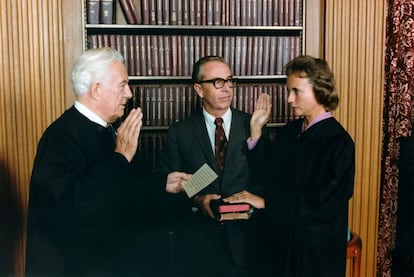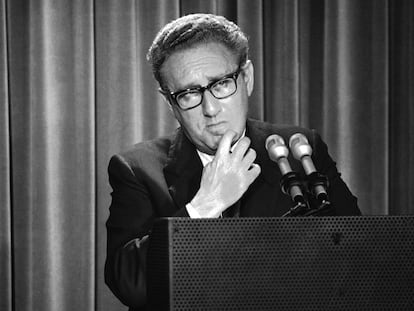Sandra Day O’Connor, first woman on the Supreme Court, dies at 93
Appointed by President Ronald Reagan in 1981, she retired in 2006. Although of conservative ideology, she earned a reputation as a moderate jurist


Sandra Day O’Connor, the first woman on the United States Supreme Court, has died at the age of 93, the Supreme Court announced. O’Connor was appointed to the highest court in the land by Republican President Ronald Reagan and served from 1981 to 2006. Although of conservative ideology, she earned a reputation as a moderate jurist. She voted in favor of abortion rights and gay rights, but above all, she broke the glass ceiling that had kept women out of the main judicial body of the United States.
Her arrival at the Supreme Court was a milestone in the struggle of women to gain a foothold in positions of power in their quest for equality. “As women achieve power, the barriers will fall. As society sees what women can do, as women see what women can do, there will be more women out there doing things, and we’ll all be better off for it,” Sandra Day O’Connor said in November 1990.
Although she graduated at the top of her class at Stanford in 1952, no California law firm wanted to hire her as an attorney because she was a woman, which happened to many female lawyers of her generation. The only job offer she received was as a legal secretary at a Los Angeles firm. However, O’Connor persisted in her job search and ended up contacting the County Attorney for San Mateo County, California. He told her that his office didn’t have the funds to hire another deputy. “I wrote him a long letter,” recounted O’Connor, “explaining all the reasons why I thought I could do things that would be useful to him in the office.” She offered to work for nothing if that was necessary. As a result of her letter, she was offered a position as a deputy county attorney.
While her husband was stationed in Frankfurt, Germany in 1954 with the Army Judge Advocate General’s Corps, she worked as a civilian attorney with the United States Army Quartermaster Corps. The O’Connors returned to the United States in 1957 and settled in Phoenix, Arizona, where she became a licensed attorney and opened a law firm with a colleague in a shopping mall. The O’Connors’ three sons — Scott, Brian, and Jay — were all born within the next six years. With the birth of her second son, she left the law practice to concentrate on her family, although she became very involved in local politics and community service.
In 1965, O’Connor returned to work full-time as an assistant state attorney general, while continuing to play an active role in Republican Party politics. When a seat in the Arizona State Senate became vacant in 1969, she was appointed to fill it. She was reelected twice, and in 1972, she became the first woman in the country to serve as majority leader in a state legislature. As a legislator, O’Connor worked towards changing various Arizona laws that discriminated against women, including a 1913 law that prohibited women from working more than eight hours a day, which had been used to prevent women from seeking and retaining employment. In addition, O’Connor pushed for laws that gave women equal responsibility for the management of community property with their spouses.
In 1975, she successfully ran for trial judge of the Maricopa County Superior Court, a position she held until 1979, when Governor Bruce Babbitt appointed her to the Arizona Court of Appeals. Her nomination to the Supreme Court followed shortly thereafter.
Although the position of Supreme Court justice is for life, Justice O’Connor announced her retirement from the Supreme Court in July 2005. Initially, President George W. Bush nominated John Roberts to replace her. However, upon the death of Chief Justice William Rehnquist in September 2005, Bush decided to nominate Roberts to fill the vacancy, and he has presided over the Court ever since. Then, in October, Bush initially nominated attorney Harriet Miers to replace O’Connor, but she decided to withdraw her candidacy. Finally, in November, Bush nominated conservative Justice Samuel Alito to fill O’Connor’s vacancy, whose resignation became effective when Alito was confirmed.
Following her retirement from the court on January 31, 2006, Justice O’Connor remained active as a tireless advocate for judicial independence and the rule of law throughout the world. In recognition of her lifetime accomplishments, President Barack Obama awarded her the Nation’s highest civilian honor, the Presidential Medal of Freedom, on August 12, 2009.
Sign up for our weekly newsletter to get more English-language news coverage from EL PAÍS USA Edition
Tu suscripción se está usando en otro dispositivo
¿Quieres añadir otro usuario a tu suscripción?
Si continúas leyendo en este dispositivo, no se podrá leer en el otro.
FlechaTu suscripción se está usando en otro dispositivo y solo puedes acceder a EL PAÍS desde un dispositivo a la vez.
Si quieres compartir tu cuenta, cambia tu suscripción a la modalidad Premium, así podrás añadir otro usuario. Cada uno accederá con su propia cuenta de email, lo que os permitirá personalizar vuestra experiencia en EL PAÍS.
¿Tienes una suscripción de empresa? Accede aquí para contratar más cuentas.
En el caso de no saber quién está usando tu cuenta, te recomendamos cambiar tu contraseña aquí.
Si decides continuar compartiendo tu cuenta, este mensaje se mostrará en tu dispositivo y en el de la otra persona que está usando tu cuenta de forma indefinida, afectando a tu experiencia de lectura. Puedes consultar aquí los términos y condiciones de la suscripción digital.
More information
Archived In
Últimas noticias
Most viewed
- Alain Aspect, Nobel laureate in physics: ‘Einstein was so smart that he would have had to recognize quantum entanglement’
- Maps of the US attack on Venezuela: Targets, airspace and deployed fleet
- David King, chemist: ‘There are scientists studying how to cool the planet; nobody should stop these experiments from happening’
- Key points of the military attack on Venezuela: Early morning bombings and a ‘captured’ president
- Maduro jailed in New York after his capture in Caracas










































